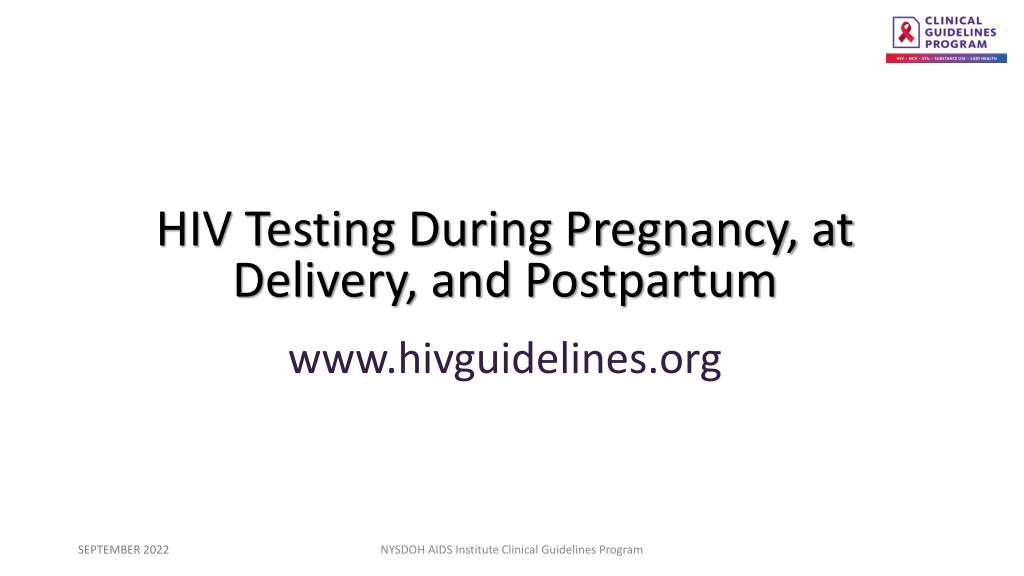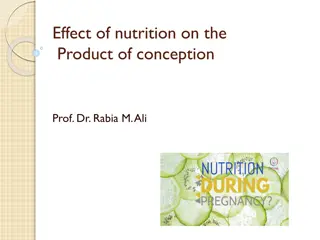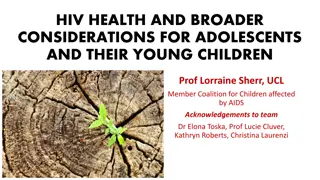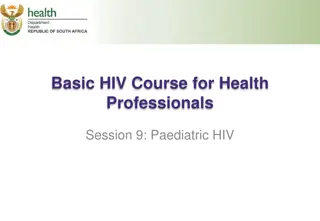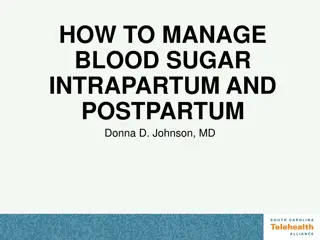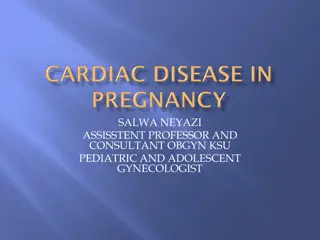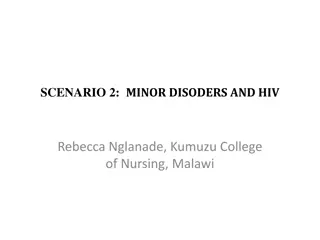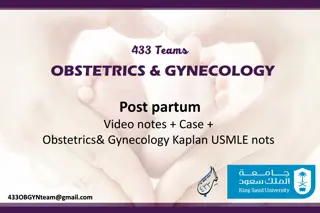Guidelines for HIV Testing During Pregnancy and Postpartum
These guidelines recommend HIV testing during pregnancy, at delivery, and postpartum. Testing should be done early in pregnancy and again in the third trimester. Expedited testing during labor is required for certain patients, and syphilis testing is recommended. Pre-exposure and post-exposure prophylaxis are available for high-risk patients. Universal screening using FDA-approved tests is advised, with prompt referral for positive cases. Testing for acute HIV is crucial when patients present with indicative symptoms. Plasma HIV RNA testing should be considered alongside serologic testing for accurate detection. Repeat testing may be necessary based on viral load levels. Follow these recommendations for optimal care during and after pregnancy.
Download Presentation

Please find below an Image/Link to download the presentation.
The content on the website is provided AS IS for your information and personal use only. It may not be sold, licensed, or shared on other websites without obtaining consent from the author. Download presentation by click this link. If you encounter any issues during the download, it is possible that the publisher has removed the file from their server.
E N D
Presentation Transcript
HIV Testing During Pregnancy, at Delivery, and Postpartum www.hivguidelines.org SEPTEMBER 2022 NYSDOH AIDS Institute Clinical Guidelines Program
Purpose of This Guideline Purpose of This Guideline In each pregnancy, HIV testing is recommended as early as possible and again during the third trimester. Expedited HIV testing during labor is required for patients without documented negative HIV status and is recommended for patients with risk factors for HIV infection. Third-trimester syphilis testing is recommended for all patients, to be performed at the same time as third-trimester HIV testing. HIV testing is recommended for any patient who presents with signs or symptoms of acute HIV infection during pregnancy or postpartum as well as for those with newly diagnosed sexually transmitted infections. Pre-exposure prophylaxis and post-exposure prophylaxis are available and recommended for pregnant and postpartum patients with negative HIV test results who are at high risk of acquiring HIV. SEPTEMBER 2022 NYSDOH AIDS Institute Clinical Guidelines Program www.hivguidelines.org
Recommendations: Universal HIV Screening in Recommendations: Universal HIV Screening in Pregnancy Pregnancy Using an FDA-approved HIV-1/2 Ag/Ab combination immunoassay and following the standard HIV laboratory testing algorithm, clinicians should screen all patients early in pregnancy, regardless of reported exposure, risk, or symptoms. (A2) Clinicians should refer patients who test positive for HIV to an experienced HIV care provider who can manage ART initiation, ideally within 3 days. (A3) SEPTEMBER 2022 NYSDOH AIDS Institute Clinical Guidelines Program www.hivguidelines.org
Recommendations: Testing for Acute HIV Recommendations: Testing for Acute HIV When a patient presents with symptoms suggestive of acute HIV infection, the clinician should perform an HIV test immediately, even if a previous HIV screening test result during the current pregnancy was nonreactive. (A2) Clinicians should maintain a high level of suspicion for acute HIV in all pregnant patients who present with a compatible clinical syndrome. (A3) When screening for acute HIV, clinicians should obtain plasma HIV RNA testing in conjunction with HIV serologic testing, preferably with an HIV-1/2 Ag/Ab combination immunoassay; the plasma HIV RNA test should be performed even if the HIV serologic screening test result is nonreactive or indeterminate. (A2) If a patient s plasma HIV RNA test result indicates a viral load 5,000 copies/mL (or 200 copies/mL for patients taking PrEP or PEP), the clinician should make a presumptive diagnosis of acute HIV, even if the results of screening and HIV-1/HIV-2 Ab differentiation immunoassays are nonreactive or indeterminate. (A2) If a patient s viral load is detectable but lower than the levels stated above, to rule out acute HIV infection, the clinician should repeat the plasma HIV RNA test 2 weeks after the first test, preferably with a repeat HIV-1/2 Ag/Ab combination immunoassay. (A3) SEPTEMBER 2022 NYSDOH AIDS Institute Clinical Guidelines Program www.hivguidelines.org
Recommendations: Third Trimester HIV and Recommendations: Third Trimester HIV and Syphilis Testing Syphilis Testing Before 36 weeks gestation (preferably between weeks 28 and 32), clinicians should repeat HIV testing for all patients with either a negative HIV test result or no documented HIV test result early in pregnancy. (A2) Clinicians should repeat HIV testing in all pregnant patients who have engaged in behaviors that put them at risk of HIV acquisition during pregnancy or have acquired other STIs. (A2) Clinicians should repeat syphilis testing along with HIV testing in the third trimester in all pregnant patients. (A2) SEPTEMBER 2022 NYSDOH AIDS Institute Clinical Guidelines Program www.hivguidelines.org
Recommendation: Recommendation: PrEP PrEP to Prevent HIV to Prevent HIV If a patient with a negative HIV test result requests PrEP or reports being at risk of HIV acquisition, clinicians should provide or promptly refer the patient for PrEP services. (A1) PrEP with TDF/FTC is not contraindicated during pregnancy or while breastfeeding an infant. SEPTEMBER 2022 NYSDOH AIDS Institute Clinical Guidelines Program www.hivguidelines.org
New York State Law: Universal HIV Screening in New York State Law: Universal HIV Screening in Pregnancy Pregnancy Clinicians in prenatal care settings must provide HIV-related information and recommend HIV testing for all pregnant patients, including those who present in labor if their HIV status is not documented. Immediately arrange an expedited HIV test, with consent, for patients in labor when no HIV test result is documented for the current pregnancy, with results available as soon as possible. SEPTEMBER 2022 NYSDOH AIDS Institute Clinical Guidelines Program www.hivguidelines.org
New York State Law: Universal HIV Screening in New York State Law: Universal HIV Screening in Pregnancy, Pregnancy, continued continued Any patient who does not have a documented HIV test result during the current pregnancy and who is not known to have HIV must, with their consent, receive expedited HIV testing during labor; results must be available within 12 hours of consent and preferably within 60 minutes. All birth facilities must have the capacity to provide and perform expedited HIV testing. Facilities should use an FDA-approved HIV screening test, with results available preferably within 1 hour and no longer than 12 hours; the most sensitive screening test available should be used to allow for detection of early or acute HIV. Ensure that expedited HIV test results are available prior to delivery to allow maximum benefits of intrapartum antiretroviral prophylaxis for the fetus. Supplemental diagnostic testing must be obtained for all preliminary positive HIV test results in pregnant patients. If a patient who presents in labor declines an HIV test, the infant is required to have an expedited HIV antibody screen at birth, with or without consent, with results available as soon as possible but no later than 12 hours after birth. If the infant HIV test is reactive for HIV antibodies, a plasma sample should be collected from the infant for HIV-1 nucleic acid testing (see New York Codes, Rules and Regulations (NYCRR) Title 10, Section 69- 1.3). The DOH-4068 Maternal-Pediatric HIV Prevention and Care Program Test History and Assessment form must be completed for every pregnant individual presenting for delivery. SEPTEMBER 2022 NYSDOH AIDS Institute Clinical Guidelines Program www.hivguidelines.org
New York State Law: Universal HIV Screening in New York State Law: Universal HIV Screening in Pregnancy, Pregnancy, continued continued The hospital shall determine the need for, and ensure provision of, HIV prophylaxis and/or treatment per standard of care to prevent transmission to the infant and shall record such in both the birth parent s and newborn s health records (see NYCRR Title 10, Section 405.21). Clinicians must discuss partner notification with patients who have been recently diagnosed with HIV, and the discussion must be documented in the medical record and on the Medical Provider Reporting Form (DOH-4189), as required by Public Health Law, Article 21, Title 3, Section 2130. SEPTEMBER 2022 NYSDOH AIDS Institute Clinical Guidelines Program www.hivguidelines.org
Key Points: Universal HIV Screening in Pregnancy Key Points: Universal HIV Screening in Pregnancy Routine STI screening in pregnancy: Routine screening for chlamydia, gonorrhea, and syphilis can be combined with HIV testing at the initial visit and at 28 to 32 weeks gestation. Sex partner STI testing: This Committee encourages healthcare providers to recommend HIV testing for sex partner(s) of pregnant patients. During the first prenatal visit, when a clinician provides counseling about HIV and other health conditions, the care provider can suggest that a patient s sex partner(s) undergo testing for HIV. The same suggestion can be made if a patient is diagnosed with a new STI or reports having new sex partners during pregnancy. Whenever possible, the clinician should offer direct linkage to HIV testing and prevention services for partners. Universal hepatitis C virus (HCV) screening: The NYSDOH AI currently recommends universal HCV screening during each pregnancy. SEPTEMBER 2022 NYSDOH AIDS Institute Clinical Guidelines Program www.hivguidelines.org
Key Points: Universal HIV Screening in Key Points: Universal HIV Screening in Pregnancy, Pregnancy, continued continued PrEP: For patients who report behavior that places them at risk for HIV acquisition, a negative HIV test result is an opportunity to encourage PrEP use. When used as prescribed, PrEP effectively prevents HIV acquisition. TDF/FTC is the preferred PrEP regimen during pregnancy and while breastfeeding. When indicated, PrEP is an effective component of a comprehensive HIV prevention plan that includes counseling and education about adherence to PrEP medications, ongoing monitoring with laboratory tests, and discussion of risk-reduction strategies. Repeat screening for HIV and other STIs (chlamydia, gonorrhea, and syphilis) is part of routine PrEP management. The use of antiretroviral medications during pregnancy is monitored through the Antiretroviral Pregnancy Registry. CEI Line for expert consultation: Clinicians in New York State can speak with an experienced HIV care provider 24/7 regarding maternal or fetal HIV exposure by calling the CEI Line: 1-866-637-2342, option 2. SEPTEMBER 2022 NYSDOH AIDS Institute Clinical Guidelines Program www.hivguidelines.org
Recommendations: HIV Testing and Prophylaxis Recommendations: HIV Testing and Prophylaxis During Labor and in Newborns During Labor and in Newborns When a patient in labor is not known to have HIV, does not have a documented third-trimester negative HIV test result, has been diagnosed with a sexually transmitted infection during pregnancy, or reports exposure risk for themselves or sex partners, the clinician should perform expedited HIV testing with consent and discuss the use of antiretroviral prophylaxis for the patient and the newborn. (A2) If the result of the expedited HIV screening test for a patient in labor is reactive, the clinician should: Obtain HIV diagnostic testing according to the standard HIV laboratory testing algorithm. (A1) Initiate maternal antiretroviral prophylaxis (A1); immediate initiation is recommended. (A3) Administer newborn prophylaxis as soon as possible after birth. (A2) SEPTEMBER 2022 NYSDOH AIDS Institute Clinical Guidelines Program www.hivguidelines.org
Recommendations: HIV Testing and Prophylaxis Recommendations: HIV Testing and Prophylaxis During Labor and in Newborns, During Labor and in Newborns, continued continued If supplemental diagnostic testing confirms that a patient in labor has HIV, the clinician should: Ensure that an HIV diagnostic test of the infant is obtained within 48 hours of birth. The infant s specimen should be sent to the Pediatric HIV Testing Service at the Wadsworth Center for a nucleic acid test (NAT) to detect HIV-1 RNA or DNA. (B3) Make arrangements for the patient with newly diagnosed HIV to see an experienced HIV care provider and, if indicated, provide referrals for case management and support services. (A3) Ensure that the HIV-exposed infant is discharged from care with antiretroviral medications in hand, not just a prescription. (B3) Make arrangements for the infant s medical follow-up with an experienced pediatric HIV care provider. (A3) SEPTEMBER 2022 NYSDOH AIDS Institute Clinical Guidelines Program www.hivguidelines.org
Key Points: HIV Testing and Prophylaxis During Key Points: HIV Testing and Prophylaxis During Labor and in Newborns Labor and in Newborns Maternal HIV acquisition and acute infection confer a significant risk of HIV transmission to an infant who is being breastfed. Of maternal seroconversion-associated transmissions that occurred between 2007 and 2018, 4 of 11 were attributed to breastfeeding among women who acquired HIV early postpartum. The peripartum period is the final opportunity to provide antiretroviral prophylaxis and decrease the risk for perinatal HIV transmission to exposed infants of individuals who have not been previously identified as having HIV. As in the prenatal and peripartum periods, when a breastfeeding patient presents with symptoms suggestive of acute HIV infection, the clinician should perform an HIV test in conjunction with a plasma HIV RNA test immediately, even if previous HIV screening tests were nonreactive. Providing information about HIV and recommending HIV testing as early as possible in pregnancy is ideal. Per New York State Law, if a patient who presents in labor declines an HIV test, the infant is required to have an expedited HIV antibody screen at birth, with or without consent, with results available as soon as possible but no later than 12 hours after birth. SEPTEMBER 2022 NYSDOH AIDS Institute Clinical Guidelines Program www.hivguidelines.org
Selected Good Practice Reminders: HIV Testing Selected Good Practice Reminders: HIV Testing and Prophylaxis During Labor and in Newborns and Prophylaxis During Labor and in Newborns If the result of the expedited HIV test for a patient in labor is reactive: Discuss the meaning of a preliminary positive HIV test result. Do not delay prophylaxis while awaiting results of confirmatory serologic testing. Inform the birth parent that HIV can be transmitted through breast milk and that breastfeeding is contraindicated until they are confirmed to be HIV negative. Refer the birth parent to a lactation specialist to assist with education and support for maintenance of breast milk supply, if so desired, so breastfeeding may be initiated if HIV infection is excluded. Provide education about the benefits of antiretroviral prophylaxis for any patient with HIV who declines it for themselves or their newborn. SEPTEMBER 2022 NYSDOH AIDS Institute Clinical Guidelines Program www.hivguidelines.org
HIV Testing and HIV Testing and Management Management Checklist Checklist SEPTEMBER 2022 NYSDOH AIDS Institute Clinical Guidelines Program www.hivguidelines.org
Need Help? Need Help? NYSDOH AIDS Institute Clinical Guidelines Program www.hivguidelines.org
Access the Guideline Access the Guideline www.hivguidelines.org > HIV Testing During Pregnancy, at Delivery, and Postpartum Also available: Printable pocket guide and PDF NYSDOH AIDS Institute Clinical Guidelines Program www.hivguidelines.org
